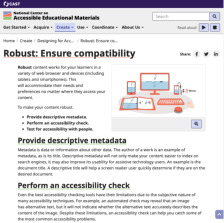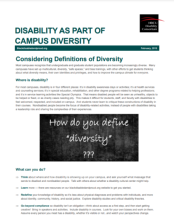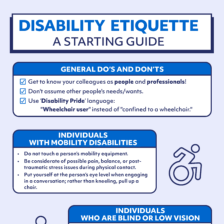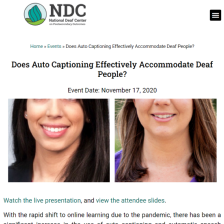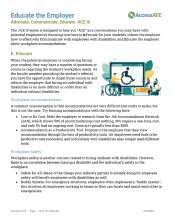Tools
Reference Material -- Nonfiction Reference
Resources | |
|---|---|
This webpage, made available by Accessible Educational Materials (AEM) at Cast, Inc., describes one of the four qualities of an accessible user experience that are captured by the acronym POUR (Perceivable, Operable, Understandable, and Robust). The principles in Designing for Accessibility with POUR come from the Web Content Accessibility...
This webpage, made available by Accessible Educational Materials (AEM) at Cast, Inc., describes one of the four qualities of an accessible user experience that are captured by the acronym POUR (Perceivable, Operable, Understandable, and Robust). The principles in Designing for Accessibility with POUR come from the Web Content Accessibility...
This resource from the Historically Black Colleges and Universities (HBCU) Disability Consortium highlights how including people with disabilities is a core component of campus diversity. Disability and diversity practices in higher education, steps to include people with disabilities, identity development, and further resources about diversity...
This booklet from the United Spinal Association provides tips for interacting more effectively with people who have disabilities. The booklet includes basic, terminology, and disability specific tips. Examples of basic tips include ask before you help, be sensitive about physical contact, and think before you speak. Some examples of terminology...
This disability etiquette guide provides general tips for working with individuals with disabilities. These tips cover general do's and don'ts, and mobility, blind or low vision, deaf or hard of hearing, speech, and non-apparent disabilities.
This video from the National Deaf Center (NDC) explores how auto captioning and automatic speech recognition (ASR) technology accommodate deaf students and staff. Accessibility and effective communication in classrooms, meetings and events, and extracurricular activities, as well as ASR best practices are highlighted. Auto captioning compared with...
This tip sheet, provided by DeafTEC at the Rochester Institute of Technology, is from the ACE It! series on acing conversations with potential employers by knowing how to advocate for students, inform the employer how to effectively communicate with employees with disabilities, and educate the employer about workplace accommodations. This tip sheet...
This resource, provided by the National Deaf Center on Postsecondary Outcomes, explores effective communication with and for Deaf individuals. An overview of effective communication, services, providers, the impact of subjective experiences, and resources on effective communication are highlighted. The resource is available in English and Spanish.
This webpage, made available by CAST, Inc., provides information on how educators can support executive functioning in online learning environments. Executive functioning is defined as "a term used to describe a set of cognitive capabilities that influence behaviors" that includes:
setting appropriate goals
planning and organizing
developing...
This 14-page research brief from the National Center for College Students with Disabilities explores financial hardships for graduate and professional students with disabilities during the Covid-19 pandemic. The resource highlights financial disparities among students who have disabilities and how they were more affected by the Covid-19 pandemic. ...
| |
| ← Previous | Next → |
